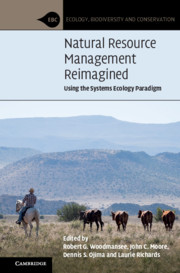Book contents
- Natural Resource Management Reimagined
- Ecology, Biodiversity and Conservation
- Natural Resource Management Reimagined
- Copyright page
- Contents
- Contributors
- Preface
- 1 The Systems Ecology Paradigm
- 2 Environmental and Natural Resource Challenges in the Twenty-First Century
- 3 Evolution of Ecosystem Science to Advance Science and Society in the Twenty-First Century
- 4 Five Decades of Modeling Supporting the Systems Ecology Paradigm
- 5 Advances in Technology Supporting the Systems Ecology Paradigm
- 6 Emergence of Cross-Scale Structural and Functional Processes in Ecosystem Science
- 7 Evolution of the Systems Ecology Paradigm in Managing Ecosystems
- 8 Land/Atmosphere/Water Interactions
- 9 Humans in Ecosystems
- 10 A Systems Ecology Approach for Community-Based Decision Making
- 11 Environmental Literacy
- 12 Organizational and Administrative Challenges and Innovations
- 13 Where to From Here? Unraveling Wicked Problems
- Index
- References
12 - Organizational and Administrative Challenges and Innovations
Published online by Cambridge University Press: 25 February 2021
- Natural Resource Management Reimagined
- Ecology, Biodiversity and Conservation
- Natural Resource Management Reimagined
- Copyright page
- Contents
- Contributors
- Preface
- 1 The Systems Ecology Paradigm
- 2 Environmental and Natural Resource Challenges in the Twenty-First Century
- 3 Evolution of Ecosystem Science to Advance Science and Society in the Twenty-First Century
- 4 Five Decades of Modeling Supporting the Systems Ecology Paradigm
- 5 Advances in Technology Supporting the Systems Ecology Paradigm
- 6 Emergence of Cross-Scale Structural and Functional Processes in Ecosystem Science
- 7 Evolution of the Systems Ecology Paradigm in Managing Ecosystems
- 8 Land/Atmosphere/Water Interactions
- 9 Humans in Ecosystems
- 10 A Systems Ecology Approach for Community-Based Decision Making
- 11 Environmental Literacy
- 12 Organizational and Administrative Challenges and Innovations
- 13 Where to From Here? Unraveling Wicked Problems
- Index
- References
Summary
The attributes and influencers that have allowed of the Natural Resource Ecology Laboratory (NREL) to exist and thrive for over five decades are described in this chapter. The chapter has two primary goals: (1) record lessons learned so other institutions wanting to establish or reinvigorate research organizations can glean ideas to help them avoid some of the pitfalls that will inevitably arise in their development, and (2) inform scientists, young and older, that when doing research using the systems ecology paradigm they do not work in organizational isolation. They stand on the shoulders of those who came before them and they depend on those around them to hold them up. Measures of success needed to be competitive, gain extramural funding support, and thrive are within organizational scientific leadership; teamwork; collaborative research; organizational pride; institutional and external influencer support; administrative functions sharing; and within-institution détente. A narrative by an organizational/industrial psychologist, who over a span of more than 25 years consulted with NREL staff on matters ranging from strategic planning and organizational management to interpersonal conflicts is presented. For developing organizations and existing organizations needing reinvigoration, ignoring his observations and insights about organizational behavior will be done at their own peril.
Keywords
- Type
- Chapter
- Information
- Natural Resource Management ReimaginedUsing the Systems Ecology Paradigm, pp. 353 - 379Publisher: Cambridge University PressPrint publication year: 2021



